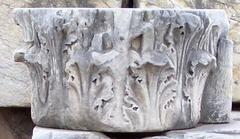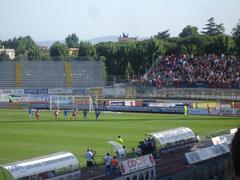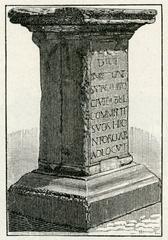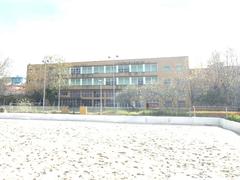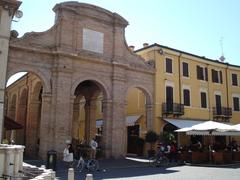Tempio Malatestiano: Visiting Hours, Tickets, and Historical Insights in Rimini
Date: 14/06/2025
Introduction: The Heart of Rimini’s Renaissance
The Tempio Malatestiano stands in Rimini’s historic center as a beacon of Renaissance art and architecture, deeply intertwined with the city’s cultural legacy and the ambitions of the Malatesta dynasty. Originally a 13th-century Gothic church dedicated to St. Francis, it was radically transformed in the mid-15th century by Sigismondo Pandolfo Malatesta. Commissioned to the humanist architect Leon Battista Alberti, the Tempio became both a dynastic mausoleum and a symbol of political power, blending classical Roman motifs with Christian iconography (History Tools; arttrip.it).
Within its walls, visitors encounter artistic treasures including frescoes by Piero della Francesca, a crucifix attributed to Giotto, and sculptural reliefs by Agostino di Duccio. The church’s striking, unfinished marble façade—modeled after Roman triumphal arches—tells a story of grand vision hindered by political and financial turmoil (Lonely Planet; Bellas Bold Adventures).
This guide offers a detailed exploration of the Tempio Malatestiano, covering its historical significance, architectural features, visitor information, and tips for an enriching visit to one of Rimini’s most revered historical sites.
Historical Context & The Malatesta Dynasty
Rimini in the Renaissance
During the 15th century, Rimini was a thriving Adriatic city, shaped by its strategic location between northern and central Italy. The Malatesta family, who began as condottieri and rose to become the city’s lords, were pivotal in shaping Rimini’s political, cultural, and architectural landscape (History Tools). Sigismondo Pandolfo Malatesta, both a military leader and a patron of the arts, brought the city to its zenith.
Transformation from Church to Temple
What began as a modest Franciscan church evolved dramatically when Sigismondo commissioned Alberti in 1447 to reimagine it as a Renaissance masterpiece. Alberti’s design drew on classical Roman forms—triumphal arches, Corinthian columns, and geometric harmony—heralding a new era in Italian architectural history (Archweb).
Architectural & Artistic Highlights
The Façade: Classical Grandeur
The Tempio’s marble façade is among its most iconic features. Inspired by Roman triumphal arches, it is characterized by three large arches, Corinthian columns, and geometric decorations. The use of ancient marble salvaged from local Roman ruins emphasizes continuity with the classical past (arttrip.it). Alberti’s initial plan included a grand dome inspired by the Pantheon, though this element was never completed due to Sigismondo’s political decline.
Interior Masterpieces
- Piero della Francesca’s Fresco: A celebrated fresco depicts Sigismondo kneeling before his patron saint, blending psychological depth with Renaissance perspective (Bellas Bold Adventures).
- Giotto’s Crucifix: The wooden crucifix attributed to Giotto predates the Renaissance renovations and bridges medieval and Renaissance artistry (Joey is a Traveler).
- Agostino di Duccio’s Reliefs: Sculptural decorations in the side chapels blend mythological figures and Christian symbolism, showcasing innovative use of light and shadow.
Spatial Organization
Alberti retained the original church’s single nave but extended it and flanked it with side chapels, intended to be tombs for the Malatesta family. The repetition of arches and pilasters, use of classical elements, and luminous interior create a solemn and harmonious atmosphere.
Political & Religious Controversy
The Tempio’s blend of secular motifs and Christian purpose aroused suspicion and criticism, especially from Pope Pius II, who condemned its “pagan” qualities and excommunicated Sigismondo. The unfinished façade and missing dome are direct results of the ensuing political and financial setbacks (Wikipedia; History Hit).
War, Restoration, and Present-Day Significance
The Tempio suffered significant damage during WWII but was meticulously restored in the postwar years. Today, it stands as a testament to resilience and the enduring appeal of Renaissance art and architecture (Nomads Travel Guide).
Visiting the Tempio Malatestiano: Practical Information
Location & Getting There
- Address: Via IV Novembre, Rimini historic center
- Access: A short walk from Rimini’s main train station, close to Piazza Tre Martiri and other major attractions. Public transport and parking are readily available (Travalour).
Opening Hours
- Monday to Saturday: 8:30 AM – 12:00 PM and 3:30 PM – 6:30 PM
- Sundays & Holidays: 9:00 AM – 12:00 PM and 3:30 PM – 6:30 PM
Hours may vary during religious services, events, or restoration; always check the official tourism website for the latest updates.
Tickets & Admission
- General Admission: Usually free; donations are encouraged to support preservation.
- Special Access: Guided tours or access to particular chapels/artworks may require advance booking or a fee.
Guided Tours & Accessibility
- Expert-led guided tours are highly recommended for deeper insight into the Tempio’s art and history (Full Suitcase).
- The site is generally accessible to visitors with limited mobility, with ramps and level entrances; contact in advance for specific needs.
Dress Code & Etiquette
- Modest attire required: cover shoulders and knees.
- Silence is appreciated, especially during services.
- Photography is permitted without flash; tripods may be restricted.
What to See & Experience
- Nave & Ceiling: Spacious interior with wooden-beamed ceiling and Renaissance art (Full Suitcase).
- Chapel of the Relics: Houses important religious artifacts.
- Unfinished Facade: Visible brickwork and incomplete designs illustrate the tumultuous history.
- Sculptures & Frescoes: Artistic masterpieces by Piero della Francesca, Agostino di Duccio, and others.
Nearby Attractions
- Arch of Augustus: Ancient Roman gateway.
- Piazza Tre Martiri: Central city square.
- Tiberius Bridge: Roman bridge with echoes of the Tempio’s design.
- Domus del Chirurgo: Archaeological site with Roman-era remains (Tourspilot).
A recommended walking itinerary: Start at the Arch of Augustus, proceed through Piazza Tre Martiri, visit the Tempio Malatestiano, and end at the Tiberius Bridge.
Practical Tips for Visitors
- Best Times: Visit in May or September for fewer crowds and pleasant weather.
- Combine with Cuisine: Sample local specialties like piadina at nearby trattorias (Tourspilot).
- Photography: Best lighting is early morning or late afternoon.
- Safety: Rimini is a safe city; standard precautions are advised.
- Language: Basic Italian enhances the experience; English tours are available.
Events, Services & Amenities
- The Tempio hosts religious services, concerts, and cultural events throughout the year. Check the official calendar for schedules.
- Souvenir shops, cafes, ATMs, and restrooms are conveniently located nearby.
Frequently Asked Questions (FAQ)
Q: Is admission to the Tempio Malatestiano free?
A: Admission is typically free; donations are welcome. Guided tours may require a fee.
Q: Are guided tours available in English?
A: Yes, through local agencies and municipal museums.
Q: Is the cathedral accessible to those with disabilities?
A: Yes, though some historic areas may pose challenges—contact ahead for details.
Q: Can I take photos inside?
A: Yes, non-flash photography is permitted.
Q: What are the best nearby attractions?
A: Arch of Augustus, Tiberius Bridge, and Domus del Chirurgo are all within walking distance.
Visuals and Interactive Resources
- [Image: Tempio Malatestiano façade at sunset — “Tempio Malatestiano in Rimini, Renaissance architecture and historical landmark”]
- [Image: Interior view with columns and frescoes — “Interior of Tempio Malatestiano with Renaissance art and architecture”]
- [Map showing location in Rimini’s historic center — “Map of Rimini historic center highlighting Tempio Malatestiano location”]
- [Virtual Tour Link (if available)]
Summary: Why Visit the Tempio Malatestiano?
The Tempio Malatestiano embodies the intersection of art, power, and faith in Renaissance Italy. Its architectural innovation, unfinished yet grand façade, and treasure trove of art make it an essential stop for travelers in Rimini. Combined with nearby historical sites and local cuisine, a visit here offers a comprehensive cultural experience (Bellas Bold Adventures; History Tools; Visit Rimini).
For up-to-date information, download the Audiala app, check official tourism resources, and plan your visit for an unforgettable encounter with Rimini’s Renaissance masterpiece.
Sources and Further Reading
- Tempio Malatestiano: Rimini’s Renaissance Masterpiece, History Tools
- Tempio Malatestiano Visiting Hours and Architectural Significance, arttrip.it
- The Artistic and Cultural Significance of Tempio Malatestiano, Bellas Bold Adventures
- Tempio Malatestiano Visiting Hours, Tickets, and Tips, Visit Rimini
- Tempio Malatestiano Overview, Lonely Planet
- The Artistic and Cultural Significance of Tempio Malatestiano, Joey is a Traveler
- Tempio Malatestiano Visiting Hours, Tickets & Visitor Information, Travalour
- Travel Tips and Itineraries in Rimini, Tourspilot
